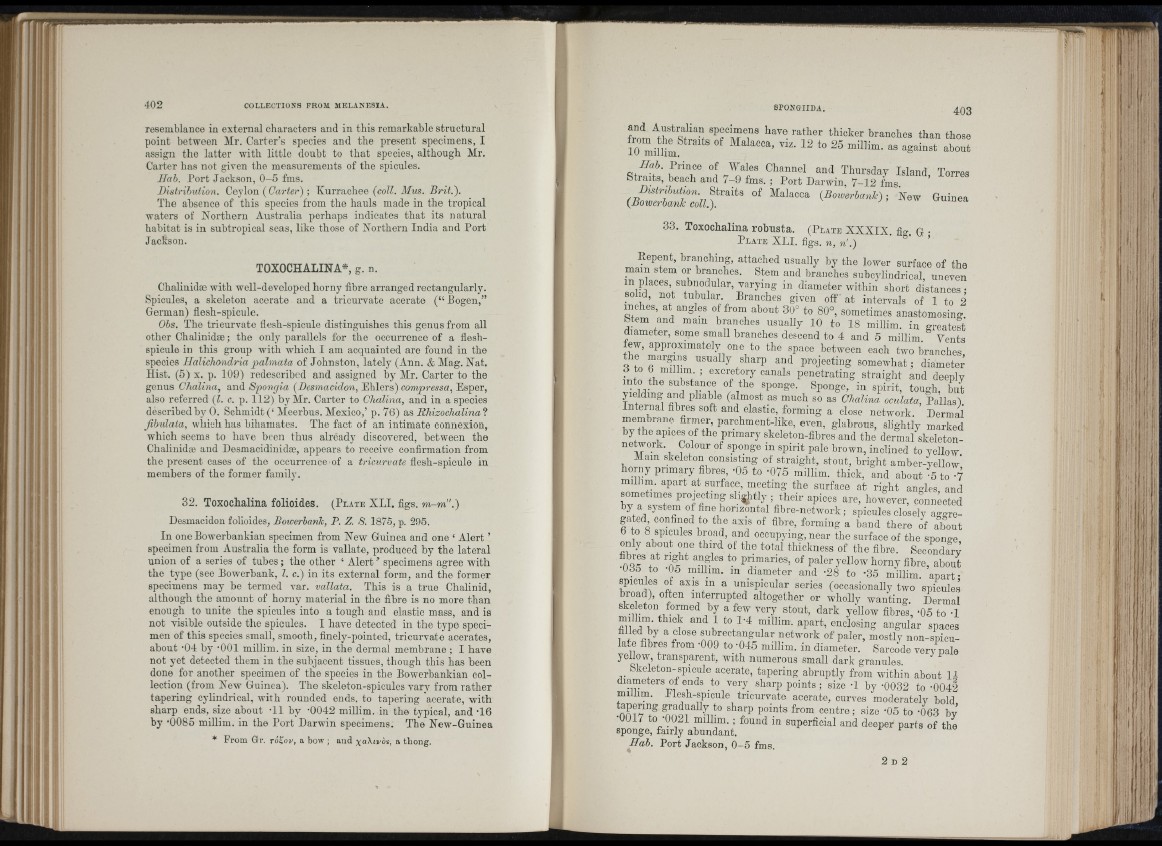
í
h
i
■
*, J í i
resemblance in external characters and in this remarkable structural
point between Mr. Carter’s species and the present specimens, I
assign the latter with little doubt to th at species, although Mr.
Carter has not given tho measurements of the spicules.
ITah. Port Jackson, 0 -5 fms.
Distrihution. Cejdon (Carter) ; Kurrachee (coll. AIus. Brit.).
The absence of this species from the hauls made in the tropical
waters of Northern Australia perhaps indicates th at its natural
habitat is in subtropical seas, like those of Northern India and Port
Jackson.
TOXOCHALINA*, g. n.
Chalinidæ with well-developed horny fibre arranged rectangularly.
Spicules, a skeleton acerate and a tricurvate acerate (“ Pogen,”
German) flesh-spicule.
Ohs. The tricurvate fiesh-spicule distinguishes this genus from all
other Chalinidæ; the only parallels for the occurrence of a flesh-
spicule in this group with which I am acquainted are found in the
species Halichondria palinata of Johnston, lately (Ann. & Mag. Nat.
Hist. (5) X . p. 109) redescribed and assigned by Mr. Carter to the
genus Chalina, and Spongia (Desmacidon, Ehlers) compressa, Esper,
also referred (I. c. p. 112) by Mr. Carter to Chalina, and in a species
described by 0 . Schmidt (‘ Meerbus. Mexico,’ p. 76) as Rhizochalina"!
fihidata, which has bihamates. The fact of an intimate connexion,
which seems to have been thus alréady discovered, between the
Chalinidæ aud Besmacidinidæ, appears to receive confirmation from
the present cases of the occurrence of a tricurvate flesh-spicule in
members of the former family.
32. Toxochalina folioides. ( P l a t e XLI. figs. m-m".)
Desmacidon folioides, Bowerhank, P. Z. S. 1875, p. 295.
In one Bowerbankian specimen from New Guinea and one ‘ Alert ’
specimen from Australia the form is vallate, produced by the lateral
union of a series of tubes ; the other ‘ Alert ’ specimens agree with
the type (see Bowerbank, I. c.) in its external form, and the former
specimens may he termed var. vallata. This is a true Chalinid,
although the amount of horny material in the fibre is no more than
enough to unite the spicules into a tough and elastic mass, and is
not visible outside the spicules. I have detected in the type specimen
of this species small, smooth, finelj'-pointed, tricurvate acerates,
about -04 by -001 millim. in size, in the dermal membrane ; I have
not yet detected them in the subjacent tissues, though this has been
done for another specimen of the species in the Bowerbankian collection
(from New Guinea). The skeleton-spicules vary from rather
tapering cylindrical, with rounded ends, to tapering acerate, with
sharp ends, size about -11 by -0042 millim. in the typical, and -16
by ’0085 millim. in the Port Darwin specimens. The New-Guinea
* From Gr. tô^ov, a bow ; aud xaXivos, a thong.
<^hi«ker branches than those
10 m illi? ' ' about
i7a6. Prince of Wales Channel and Thursday Island Torres
Straits, beach and 7-9 fms. ; Port Darwin, 7-12 fms ’
“ “ ““ te » “ ' » « ) I B w Guinea
33. Toxochalina rohusta. ( P l a t e XXXIX. fio-. G •
P l a t e XLI. figs. n, n'.) ^ ’
Bepent, branching, attached usually by the lower surface of the
mam Gem oi branches. Stem and branches subcylindrical, uneven
s o i ? T V '1 diameter within short distances;
solid, not tubular. Branches given oft” at intervals of 1 to 2
inches, at angles of from about 30° to 80°, sometimes anastomosing.
Stem and mam branches usually 10 to 18 millim. in greatest
diameter, some small branches descend to 4 and 5 millim. Vents
few, approximately one to the space between each two branches,
8 m f i s h a r p and projecting somewhat ; diameter
into penetrating straight and deeply
into the substance of the sponge. Sponge, in spirit, tough, but
T f R R (almost as much so as Chalina oculata, Pallas).
Internal fibres soft and elastic, forming a close network. Dermal
membrane firmer, parchment-like, even, glabrous, slightly marked
by the apices of the primary skeleton-fibres and the dermal skeleton-
network. Colour of sponge m spirit pale brown, inclined to yellow
Mam skeleton consisting of straight, stout, bright amber-yellow'
horny primary fib re/ -05 to -075 millim. thick, and about 5 to 7
milhm. apart at surface, meeting the surface at right angles and
some -imes projecting slightly ; their apices are, however, competed
by a system of fine horizontal fibre-network ; spicules closely aggregated
confined to the axis of fibre, forming a band there of about
6 to 8 spicules broad, and occupying, near the surface of the sponge
only about one third of the total thickness of the fibre. Secondarj;
hhres at right angles to primaries, of paler yellow horny fibre, about
035 to -05 millim. m diameter and -28 to -35 millim. apart-
/iicules of axis m a unispicular series (occasionally two spicules
broad), often interrupted altogether or wholly wanting. Dermal
ske eton formed by a few very stout, dark yellow fibres, -05 to -1
milhm thick and 1 to 1-4 millim. apart, enclosing angular spaces
filled by a close snbrectangular network of paler, mostly non-spicu-
1am fibres fiom 009 to -04o millim. m diameter. Sarcode very pale
yellow, transparent, with numerous small dark granules.
Skeleton-spicule acerate, tapering abruptly from within about
diameters of ends to very sharp points; size G by ’0032 to -0042
milhm. Elesh-spicule tricurvate acerate, curves moderately hold
tapering graduaUy to sharp points from centre ; size ’05 to ’063 by’
0017 to 0021 milhm. ; found in superficial and deeper parts of the
sponge, fairly abundant.
Hah. Port Jackson, 0 -5 fms.
: I